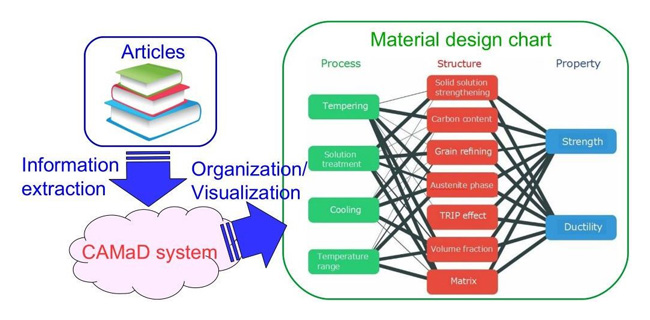AI Capable of Outlining in a Single Chart Information from Thousands of Scientific Papers
—Computer-Aided Material Design System Expedites Material Design by Automatically Extracting Process-Structure-Property Relationships—
2018.09.25
National Institute for Materials Sciences
NIMS and the Toyota Technological Institute at Chicago have jointly developed a Computer-Aided Material Design (CAMaD) system capable of extracting information related to fabrication processes and material structures and properties—factors vital to material design—and organizing and visualizing the relationship between them.
Abstract
- NIMS and the Toyota Technological Institute at Chicago have jointly developed a Computer-Aided Material Design (CAMaD) system capable of extracting information related to fabrication processes and material structures and properties—factors vital to material design—and organizing and visualizing the relationship between them. The use of this system enables information from thousands of scientific and technical articles to be summarized in a single chart, rationalizing and expediting material design.
- The performance of a material is determined by its properties. Because a material’s properties are greatly influenced by its structure and by the fabrication process that controls the structure, understanding the relationships between factors affecting material properties of interest and associated material structures and fabrication processes is vital to rationalizing and expediting the development of materials with desirable performance. Materials informatics—an information science-based approach to materials research—allows the relationships between these factors to be extracted from large amounts of data using deep learning. However, because the collection of large amounts of data on materials through experiments and database construction is labor-intensive, it had been difficult to use materials informatics to integrate process-structure-property-performance relationships into material design.
- This research group has developed a system able to extract and identify relationships between factors related to processes, structures and properties vital to material design by instructing computers to read the text of scientific articles—rather than numerical data on materials—using natural language processing and weekly supervised deep learning. The material designers initially select several material properties relevant to desirable material performance. Based on these selections, the computer then extracts relevant information, determines the type and strength of relationships between material structures relevant to the desirable properties and factors related to structure-controlling fabrication processes and generates a chart to visualize these relationships. For example, if a steel designer selects “strength” and “ductility” as material properties of interest, the computer produces a chart illustrating the relationship between structural and process factors relevant to composite microstructures known to influence these two properties.
- In this pioneering effort, we actively integrated natural language processing and deep learning into material design. We have publicized the AI source code developed in this study for use by others, free of charge, to promote related research.*
*Link to the source code: https://bitbucket.org/0024takeshi/pspp_relation - This research project was carried out by Ikumu Watanabe (Senior Researcher, RCSM, NIMS), Takuya Kadohira (Group Leader, MaDIS, NIMS) and Takeshi Onishi (Ph.D. student, Toyota Technological Institute at Chicago).
This study was published in Science and Technology of Advanced Materials on September 19, 2018.

Computer-Aided Material Design (CAMaD) system extracts relevant information from scientific articles and summarizes it in a chart.
Related files
- Research Center for Structural Materials(RCSM)
Contacts
(Regarding this research)
-
Ikumu Watanabe
Senior Researcher,
High Strength Materials Group, Analysis and Evaluation Field,
Research Center for Structural Materials,
National Institute for Materials Science
TEL: +81-29-859-2118
E-Mail: WATANABE.Ikumu=nims.go.jp
(Please change "=" to "@") -
Takeshi Onishi
Ph.D. Student, Toyota Technological Institute at Chicago
E-Mail: tonishi=ttic.edu
(Please change "=" to "@")
(For general inquiries)
-
Public Relations Office
National Institute for Materials Sciences
Tel: +81-29-859-2026
Fax: +81-29-859-2017
E-Mail: pressrelease=ml.nims.go.jp
(Please change "=" to "@")
Same Keywords
-
Discovery of a New Magnetic Sensor Material Using a High-Throughput Experimental Method
(AI)
2025.09.04
-
Machine Learning-Developed Maps for Discovering New Phases Released
(Materials informatics)
2025.04.15
-
Increasing High-Temperature Strength of Materials Through Collaborative Efforts of AI and Materials Researchers
(AI)
2023.09.25
Recent Press Release
-
Simultaneous Imaging of Intracellular DNA and RNA Using Harmless Light
2025.10.27
-
Development of an AI Device Using Ion Gel and Graphene That Dramatically Streamlines Machine Learning Computations
2025.10.14
-
Demonstrating a Novel Method to Modulate Heat Flow Through the Collective Motion of Spins
2025.10.06
